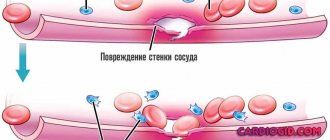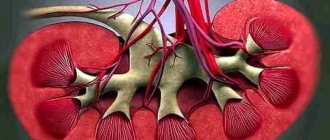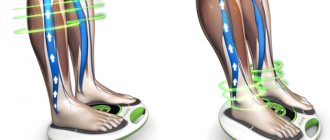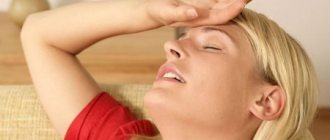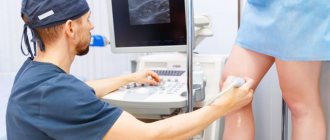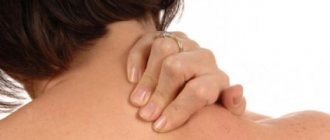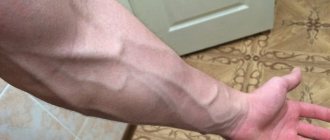Bruises on the body: normal or pathological?
Hematoma, or petechiae, is the main clinical manifestation, the presence of which can indicate that a blood vessel has burst on the finger. In the photo it looks like an ordinary bruise under the skin, simply put, a bruise that occurs in healthy people due to strong mechanical impact. Blood vessels are so strong and elastic that they can easily withstand short-term pressure, and no traces remain under the skin. Otherwise, when a certain force is applied, the vessels cannot withstand and rupture. There is no need to worry that a blood vessel on your toe or hand has burst due to an injury - the bruise will heal in a few days.
Hematomas of a different origin on the body should cause real concern. Bruises may indicate diseases in the body that require consultation with a phlebologist and the prescription of correct therapy.
Problems with the vascular system more often occur in old age, which is associated with the formation of atherosclerotic plaques on the walls of the arteries. Over the years, settling salts and lipids accumulate and interfere with proper blood supply. By the age of sixty, in patients who have not followed a diet or maintained a healthy lifestyle over the past years, the blood vessels are worn out and fragile.
Why do bruises appear on the body without contusions?
Appearance is important for everyone living on earth.
At first, attention is drawn to open parts of the body: the face, arms and legs. Therefore, they pay all attention to the skin of their face and hands. But you need to know that it's not just about aesthetics. A person's health is directly reflected in his skin. A hematoma occurs when a part of the body hits something. But in some people they appear without mechanical damage, without any visible and clear reason. Why bruises appear on the body on their own is a fairly important question for people, so it will be discussed here.
To determine the mechanism of their appearance, it is necessary to study all the factors.
Why do bruises appear on the body on their own?
Hematoma
- This is an accumulation of blood clots under the skin, formed when blood vessels and capillaries are injured.
Internal vessels rupture. If the cause of the vascular damage was a bruise, it will go away quickly. If the reasons are damage to blood vessels due to disease, then they last longer.
Adults look at this problem as the approach of old age. Some people don't pay attention because bruises accompany them throughout their lives. And a small percentage of people begin to look for the reason for this and try to eradicate it.
Why do bruises appear on the body for no reason?
Why do bruises appear on the body on their own?
There are many aspects that help us understand why bruises appear on the body without being hit. The most common reason is that the capillary walls become brittle.
A new question arises: why do they become brittle? It has been noticed that in a beautiful field they are observed more often and in greater numbers. This is due to the fact that the woman’s hormonal balance is disturbed; she lacks the female hormone – estrogen. This is especially true during menopause.
Advanced age is also a factor in why bruises appear on the body just like that. The body of an adult, elderly patient lacks useful microelements, minerals and vitamins. This affects the condition of blood vessels and capillaries. Playing sports also has an impact. Muscles tense, blood vessels rupture, and bruises occur.
Why do bruises spontaneously appear on the body?
Vitamins C and P are important for the strength of capillaries. If there is not enough C, then tissue restoration after damage slows down. With a deficiency of P, capillaries become fragile and brittle, this causes the appearance of hematomas.
In this case, Ascorutin is prescribed, which is aimed at thickening the vascular walls. It acts like a vitamin.
The appearance of bruises on the body is also affected by long-term use of medications that thin the blood. For example, aspirin.
Why do bruises appear on the body without contusions?
Why do bruises appear on the body without contusions?
There are serious factors why bruises spontaneously appear on the body. Their appearance may indicate liver dysfunction. A qualified specialist can clarify the situation.
The disease purpuric dermatitis manifests itself in the appearance of many small bruises on any part of the body, most of which are localized on the legs. Older people are more likely to suffer from this.
Diabetes causes disturbances in sugar levels and affects the circulatory system. Thus, diabetics have fragile and permeable blood vessels.
Blood clotting disorders also lead to the problem under consideration.
There may be such diseases:
- vasopathy - the walls of blood vessels are damaged by the action of infectious, toxic or immunoallergic agents;
- coagulopathy – there is a decrease in the level of blood clotting;
- thrombocytopenia - with this disease there is a decrease in the number of platelets due to their inhibition, trauma and other reasons;
- thrombocytopathy – here the abilities of the platelet unit are weakened.
Another reason why bruises appear on the body without blows is oncology. With this disease, there is a deviation from the norm of blood clotting.
The systematic appearance of bruises is a sign of the onset of the disease.
Summarizing the above, there are 3 factors why hematomas spontaneously appear on the body:
- violations of the walls of blood vessels;
- lack of platelets;
- pathology of blood clotting.
on the subject: Why do bruises appear on the body for no reason?
Conclusion
Only a doctor can determine the problem. In this matter, consultation with a hematologist or endocrinologist is necessary. If there are suspicions, the specialist will refer you for tests and, if necessary, to additional doctors. The result of treatment is to eliminate the causes that cause the appearance of hematomas without mechanical damage to the skin.
The prognosis for treatment depends on what disease is detected during the study, but it is generally favorable.
Rare and single hematomas should not cause concern. A person could hit himself and not pay attention to it. A reason for concern is the frequent appearance of bruises.
In such a situation, it is necessary to consult a qualified doctor in a timely manner.
Did you read the article to the end?! Like and subscribe to our channel!
Source: https://zen.yandex.ru/media/id/5b7908d16609b800a96da0d1/5bc03dfdc6f3c100ad4768a2
In what cases can you do without treatment?
Quite often people go to the doctor with a complaint that a blood vessel has burst on the finger. Practice shows that capillaries on the upper extremities are damaged much less frequently in patients than on the lower extremities. Despite the fact that a person moves his hands more actively, the additional load only benefits the joints and blood vessels. It is extremely important to recognize the true cause of this problem. If blood vessels often burst in the arms or legs, first of all you should reconsider your lifestyle and exclude the following points:
- Physical exercise. Damage to small blood vessels occurs as a result of long-term strength training, which becomes an excellent background for a jump in blood pressure.
- Chronic and infectious diseases. Such diseases lead to a weakening of the immune system and, accordingly, negatively affect the state of the cardiovascular system.
- Allergy. By eliminating the irritant (any allergen provokes vascular hypertonicity), the patient can forever forget about the problem with bursting blood vessels. Particular attention should be paid to household chemicals.
- Cosmetic procedures, including peeling, visiting a solarium. Prolonged exposure to the scorching sun or frostbite of the extremities can lead to damage to small vessels.
If at least one of these factors is present, they usually speak about the non-pathological nature of the origin of the problem. Elimination of this factor will allow, over time, to restore the firmness and elasticity of the arterial and capillary walls.
Treatment methods
Treatment of any pathology depends on the cause that provoked it. Therapeutic measures for pronounced veins can be medicinal and surgical.
The last option is resorted to in two cases: either if the disease progresses and there is a risk of a large blood clot, or if the patient simply wants to eliminate an aesthetic defect.
| Cause of Vein Swelling | Therapy |
| Thrombophlebitis | Antiplatelet agents and anticoagulants, anti-inflammatory drugs, warm compresses. |
| Hereditary predisposition | An aesthetic problem that is inherited can only be eliminated through surgery. |
| Increased physical activity | Moderate exercise or temporary refusal of it will make the veins less noticeable. |
| Varicose veins | Surgical intervention or conservative treatment. |
General recommendations
To enhance the effect of drug or surgical therapy, you need to help the body remove (hide) visible veins.
- Drink enough clean, non-carbonated water. This will improve the structure of the skin of your hands, it will become smoother and more elastic.
- Avoid coffee and alcohol. This will make the skin color uniform, without a “gray” tint.
- Use hand creams. This can be either a simple moisturizer or a special anti-varicose cream. The latter will improve the tone of blood vessels, and, if the problem has not gone far, will hide them.
Hand exercises
There is a whole list of exercises (pictured below) that will help eliminate large veins.
Here are the most effective:
- Clasp your hands into fists, lower and raise them “all the way”, bending your hands – 10 times.
- Alternately extend your fingers to the back, then together.
- Gather the fingers of the right and left hands into a bun, lower them together downwards, bending the hand, return to the starting position - 10 times.
- Work your thumbs: pull them back and forth and to the sides.
- Clenching your hands into fists, twist them, bending your wrist.
- Forcefully bend and straighten your fingers into fists – 10 times.
- Place your palms together in front of your chest, bend your arms at the elbow joints, raise your elbows up, lowering your hands to your navel.
- Walk along any surface with your fingers, imitating playing the piano.
- Straighten your arms, point them in different directions, swing them in a circle - forward and backward.
- In the same position, bend your elbows and make circular movements of your limbs, first to the right, then to the left.
Such exercises, performed daily, can really improve the aesthetic appearance of the hands by restoring the tone of the blood vessels.
Conservative treatment is aimed not only at eliminating the visible defect, but also at stopping the cause that caused it.
| A drug | Group | Action |
| Venobene, Troxevasin, Dolgit | Local application | Relieves pain |
| Dipyridamole, Clopidogrel, Aspirin, Cardiomagnyl | Antiplatelet agents | Reduce the risk of blood clots, improve blood flow |
| Urokinase, Fibrinolysin, Trypsin | Fibrinolytics | Thinning blood, preventing blood clots |
| Trental, Pentoxifylline | Improved blood circulation | Prevents blood stagnation in the extremities, vasoconstriction |
| Ibuprofen, Ketonal, Dicloberl, Meloxicam | NSAIDs (non-steroidal anti-inflammatory drugs) | Relieves inflammation and pain |
Remember that you should never prescribe medications and treatment for yourself! This label is provided for informational purposes only.
Among the physiotherapeutic procedures that can help are taking a contrast shower twice a day for at least 10 minutes, and massage. It can even be done independently, at home, either with your hands or with the help of various massage devices. For dry skin, you should use cosmetic oil.
Hand baths (used in nail salons) are also used. Modern models are equipped with an infrared emitter; it is possible to conduct a session of magnetic therapy and vibration massage. Such comprehensive care will definitely improve the appearance of the hand area, relieve fatigue and relax them.
If, as a result of the course of the disease, the veins are very prominent, and drug treatment has no effect, then the patient will definitely undergo surgery. If there are no pathologies, but bloating is observed for some non-serious reasons, for example, as a result of heredity, then everything depends only on the desire of the patient himself.
There are several surgical options:
- Phlebectomy. This is the complete removal of a vein affected by varicose veins using special instruments.
- Sclerotherapy. This type of surgical intervention involves turning off the vein from the bloodstream (its functions are assigned to other vessels) and filling it with a special sclerotic fluid.
- Laser therapy. Veins that are swollen disappear under the influence of a laser, which glues them together from the inside. This is the most painless and gentle operation.
- Ultrasound thrombolysis. It is used if a blood clot has formed in the bloodstream. Then, with the help of a certain wavelength, it is destroyed.
Depending on the chosen surgical procedure, the rehabilitation period will vary. The shortest is with laser therapy, the longest is with phlebectomy. In the latter case, hands should not be subjected to heavy physical effort for a month.
Treatment of altered blood vessels is not limited to cosmetic procedures alone. It is necessary to adhere to the doctor’s recommendations regarding diet and diet.
A balanced diet (not hunger strikes) and feasible exercise will help you lose excess weight. Among the foods you should avoid, fatty and fried meat foods, hot sauces and seasonings, smoked foods, and confectionery products. It is recommended to include in the menu: vegetables, fruits, poultry and fish, dairy products.
Contrast showers twice a day help maintain the necessary general vascular tone.
For pain and swelling, wearing a compression sleeve and special gloves helps. They are worn with the arm raised.Medicines should be taken only as prescribed by a doctor. Ointments based on Troxerutin, horse chestnut, Phlebodia tablets, and Detralex have a good effect.
Medicinal leeches (hirudotherapy) can be used if there is a tendency to thrombosis or inflammation of the vascular wall. This type of traditional therapy is not considered effective by all doctors. There are enough contraindications and questionable effects.
The sclerotherapy method has become widespread in recent years. Allows you to quickly eliminate twisting venous cords and improve the appearance and rejuvenate your hands.
However, it should be remembered that it does not act on the cause of the disease. In this method, the result is achieved by stopping blood circulation through the vein by introducing sclerosant drugs inside, causing adhesion of the internal walls of the vessel.
For surgical removal of veins in the arms, serious indications are required. In the treatment of Parkes-Weber-Rubashov disease, ligation of anastomoses between arteries and veins is used. But this method is not very effective, since there are a lot of such anastomoses, it is impossible to bandage everything. If gangrene threatens, the arm must be amputated.
We often see people having bulging veins in their arms. After the face, the hands are the most visible part of the body. The appearance of such veins is not always a sign of illness.
What we see on the hands are superficial veins; they lie just below the surface of the skin. You will not be able to notice the deep veins as they lie deep inside the body.
Pigment spots and wrinkles, swollen veins - their appearance bothers many people. They are more of a cosmetic problem, although this is not the only reason.
There are several reasons why this problem appears on the hands, let's find out more about them.
Causes
Important: in any case, swelling and blueness of the finger is a signal of disorders in the body that require careful study and treatment determined by a doctor.
The condition of swelling can be alleviated with the help of medications and traditional medicine.
Methods for relieving pain, eliminating swelling and blue discoloration of the injured finger depend on the cause that provoked this condition.
In this situation, the victim must be given first aid and taken to the emergency room. Cold lotions (you can use frozen foods or ice) will help prevent the development of large-scale swelling and hematoma on the arm.
As a last resort, the damaged phalanx is generously moistened with cold water. If you suspect a fracture, before seeking help from a doctor, you must apply a homemade splint to the sore spot and secure it with a bandage.
Bruises and swelling - symptoms of arthritis and arthrosis are treated with anti-inflammatory drugs (in the form of tablets, injections, topical applications).
After a bruised vein in an arm or leg, treatment is carried out using medications from various groups. Most often prescribed:
- Non-steroidal anti-inflammatory drugs. They help relieve pain and stop the spread of the inflammatory process. The most effective drug is Ibuprofen.
- Anticoagulants. Drugs in this group are prescribed for severe vein swelling and swelling of the skin. They help prevent the formation of blood clots and blockage of blood vessels.
Excess weight
Excess body weight causes increased stress on the heart and circulatory system. In obese people, varicose veins of the lower extremities are a very common disease, characterized by swelling of blood vessels and the formation of painful nodules with bruising.
If an overweight patient leads a sedentary lifestyle, the risk of blood stagnation and blood clots increases. Office workers, drivers and representatives of other “sedentary” professions often ask why a blood vessel burst on their finger.
Basic therapy methods
If the veins become very enlarged and protrude, but there are no blood clots or a threat to health, alternative medicine can come to the rescue. This is a whole set of folk recipes, treatment with leeches, acupuncture.
Important: before deciding on unconventional methods of treatment, you need to consult a doctor and make sure that the chosen method will not harm or aggravate the situation. Poor patient tests will be the first contraindication for the use of alternative medicine methods.
Reviews from doctors about alternative medicine are mixed, but all experts agree that they can only be used when there are no blood clots or visible varicose veins.
Folk recipes
We bring to your attention popular recipes for folk remedies that can help with swollen veins in the hands:
- Take a green tomato (according to the degree of ripeness), cut it into slices, place it on your hand in the place where the veins emerge and swell, and wrap it with an elastic bandage overnight. In the morning, remove everything and spread the skin with a high-fat cream.
- Mix crushed wormwood (3 tablespoons) with the same amount of curdled milk, smear the resulting medicine on your hand and wrap it in cling film. After 20 minutes, remove the compress and spread the skin with rich cream or sour cream. This will take up to a month.
- Apple cider vinegar and birch bud tincture are mixed 1:1, rub your hands with the resulting mixture twice a day.
- Chopped garlic and butter in equal proportions are mixed and applied to the hands in places where the veins are swollen. The compress needs to be insulated as much as possible (using cling film and a towel on top). You will have to smear visible veins for up to 5 months.
- Drink herbal tea: rose hips, blueberry leaves, rowan berries and St. John's wort are mixed in equal parts. Take half a glass twice a day, brewing a tablespoon of the resulting tea with boiling water.
Hirudotherapy
Treatment with leeches is practiced even with pronounced veins, when the hands swell from insufficient blood outflow.
The essence of hirudotherapy is that a specially grown medical leech is placed on a patient at a certain point on the body. During the bite, a substance, hirudin, enters the blood, which thins it and prevents blood clots.
Patients note an improvement in the appearance of their hands and overall well-being after the first session. After manipulation, the leech is placed in medical alcohol.
Acupuncture
Using this method, certain points of the human body are affected by introducing special thin needles into them. They activate biological processes in the body, thereby restoring normal blood flow and preventing congestion.
This method is not recommended for everyone, as it has a number of contraindications. Before deciding to go to an acupuncture session, you need to take all the tests and notify your doctor.
Hands are subject to constant physical activity, which increases blood flow. As a result, the development of congestion and a noticeable dilation of blood vessels in the arm may be observed. If a person has swollen blood vessels, then there are several ways to get rid of this problem:
- Using laser treatment.
- Using ultrasound therapy, bloating can be eliminated.
- Thanks to the use of certain groups of drugs that the doctor will prescribe, taking into account why the veins in the patient’s arms have formed.
- If the vessels are swollen, then this defect can be eliminated using minimally invasive treatment methods: for example, sclerotherapy.
- With the help of surgery in the arm area.
Having received information about why a problem of this nature can form on the hands, it is recommended to refrain from self-medication.
Fragile capillaries as a symptom of a serious illness
The health of the vascular system and the condition of arteries, veins and capillaries are negatively affected by pathologies of the endocrine system (thyroid gland), accompanied by hormonal surges. In patients suffering from diabetes, blood vessels burst very often. The problem can also arise with kidney pathologies and vegetative-vascular disorders.
One of the most common pathological causes of fragility of blood vessels is arterial hypertension, with the progression of which the walls of the capillaries are significantly weakened and cannot cope with the load that occurs during sudden surges in blood pressure.
Etiology
Increased fragility of the blood vessels of the hands, leading to their periodic damage with the formation of a hematoma (blood leakage into the tissue), is a polyetiological pathological condition. This means that it develops due to the influence of a significant number of different factors. For ease of diagnosis, all factors are divided into endogenous and exogenous causes. Endogenous factors take place inside the human body and usually represent various diseases:
- Disorders of the endocrine system, characterized by an increase or decrease in the level of certain hormones (diabetes mellitus, thyroid disease).
- Increased systemic blood pressure, called hypertension.
- An autoimmune inflammatory process accompanied by “erroneous” synthesis of antibodies to the structures of capillary walls with their subsequent weakening (rheumatism, systemic lupus erythematosus).
- Some acute infectious diseases leading to damage to microcirculatory structures (scarlet fever, influenza, measles).
- Allergic reactions are the body’s increased sensitivity (hypersensitization) to certain foreign compounds; contact with them is accompanied by a specific immune response with vascular damage.
- Excessive load on the central nervous system (stress, psycho-emotional overstrain), which is the cause of the development of neuroses.
- Vegetovascular dystonia (VSD) is a change in the functional state of microcirculatory structures, which include arterioles, capillaries and venules.
- Insufficient intake of certain vitamins into the body (hypovitaminosis), which are responsible for the strength of the walls of blood vessels, these include vitamin P (rutin) and C (ascorbic acid).
- Metabolic disorder, accompanied by a significant increase in body weight and functional load on the vascular bed.
- Age-related weakening of the walls of various vessels against the background of degenerative processes that occur in older people.
The presence of endogenous factors leads to the fact that bruises appear in a person for no apparent reason. For effective treatment, the underlying disease is diagnosed.
Exogenous etiological factors include various external influences leading to disruption of the integrity of the walls of blood vessels in the hands:
- Traumatic injury - bruise, cuts.
- Previous burns or frostbite.
- Cosmetological manipulations that include exposure to various physical or chemical factors. They can affect the microvasculature (peeling, laser skin resurfacing).
- Exposure to adverse environmental factors, such as ultraviolet irradiation (insolation, solariums), radiation, aggressive chemical compounds (acids, alkalis).
- Long-term systematic use of certain medicinal compounds (antidepressants, anti-asthmatic, anti-inflammatory, hormonal drugs).
- Physical fatigue, including heavy training in athletes.
In most cases, the development of increased fragility of blood vessels in the arms and fingers of young people, as well as old people, can be prevented by modifying lifestyle aimed at eliminating the effects of exogenous factors.
A blood vessel burst on the thumb: how does it manifest itself?
Rupture of capillaries is accompanied by the appearance of a hematoma. Due to extensive internal hemorrhage resulting from ruptured capillaries, red dots on the skin become noticeable. If a vessel bursts on a finger (we’ll find out what to do in this case later), a bluish spot becomes visible to the naked eye, which is painful to touch.
To determine the degree of fragility and fragility of the walls of blood vessels in the arms and legs, they resort to the use of simple methods - pinching and applying a tourniquet.
In the first case, you will need to select a specific area of skin with a minimum pain threshold. They pinch the skin fold with their fingers and try to move it. If a bruise forms at the site of manipulation, it means that the vessels are weakened, fragile and inelastic. The tourniquet method, unlike the pinch method, involves briefly pressing the arm slightly above the elbow joint. The formation of a bruise under the constriction site will indicate problems with the capillaries.
Treatment prognosis and possible complications
Damage to the phalanges of the fingers, especially in children, does not go away without leaving a trace. Of course, this depends on the nature and severity of the injury. A small bruise is unlikely to be noticeable after a few years, which cannot be said about more serious injuries.
Human soft tissues are quite capricious. When injured, changes may occur in them that can lead to complications. Often they do not appear immediately, but some time after the injury. Remember that if the damage is not treated, recovery will take a very long time. It is better to use all the advice and get rid of painful sensations in the finger using medications and folk methods.
Often a finger injury is accompanied by damage to the nail plate. This creates microscopic cracks through which infections enter the wound. This can cause extremely unpleasant consequences, including blood poisoning. To protect the body from this, you should treat the edges of the wound with iodine as quickly as possible. This product not only disinfects, but also accelerates the resorption of the hematoma. Hydrogen peroxide is also suitable for disinfection.
If the injury is severe, the nail may turn black and peel off.
If the injury is very severe, the nail may turn black and peel off. In this case, postponing a visit to the doctor can be very dangerous. It is necessary to fix the nail in its place with a plaster and bandage, and then immediately seek help.
Hemarthrosis is a common occurrence when a finger is bruised. It is a hemorrhage and subsequent accumulation of blood in the joint cavity. The reason is damage to the blood vessels during the impact.
The accumulation of blood in the joints is called hemarthrosis
Hemarthrosis is quite easy to detect. With this complication, the joint increases in size and takes on a spherical shape. If the accumulation of blood is small, it will most likely resolve on its own. For more serious injuries, the doctor may prescribe a puncture or a plaster cast.
If a hematoma appears frequently and for no reason, in this case only a specialist will help. Thanks to him, a diagnosis will be made in a timely manner and treatment of the underlying disease will be prescribed.
Mild forms of damage go away on their own. If the hematoma on the arm from the blow is complex and extensive, then complications may arise. If the bruise should have been opened, but this procedure was not performed, scar tissue may form or suppuration may appear. This leads to constrained hand movement and discomfort.
Partial resorption of the hematoma leads to purulent-inflammatory processes. If you continue to not consult a doctor, the situation will worsen and sepsis, necrotization, tissue rejection or blood poisoning may occur. Therefore, you should not joke with extensive hematomas.
Features of treatment
If a vessel on a finger has burst not for the first time (regardless of whether it is on the upper or lower limb), it is necessary to establish the cause of the rupture of the capillaries and resort to drug therapy to strengthen them. Today, pharmacies sell many effective products used to maintain the walls of blood vessels. One of the universal drugs is Troxevasin. It is available in the form of capsules, ointments, gels, and is used for the speedy healing of bruises and the resorption of small subcutaneous hematomas.
In the case when a vessel bursts on a finger due to arterial hypertension, it is important to monitor blood pressure and prevent hypertensive crises. Capillaries are damaged both by sudden expansion and by sudden spastic contraction. In order to thin the blood and prevent the formation of blood clots, patients are prescribed anticoagulants, including ordinary Aspirin.
Treatment
There are many medications that can affect the narrowing of blood vessels, which are better to get rid of permanently.
The main medications used to increase the activity of vascular walls are complex treatment with vitamins C and P - rutoside, ascorutin, capillary. The next step is to make changes to your diet and add ingredients rich in such vitamins to your diet - rowan fruits, currants, rose hips.
Askorutin
A proven and effective way to strengthen blood vessels is hardening. You need to pour cold water over your body and then hot water. But this method is suitable for a small degree of fragility. Otherwise, a sharp temperature change, on the contrary, can cause stains to appear.
Physical exercise will serve as a good stimulation of blood flow in the vessels, prevention and treatment of the condition of the vascular walls. Smokers are advised to abstain from using tobacco for a while. Nicotine causes the walls of blood vessels to narrow, which makes the task very difficult.
Vitamins for capillary health
If a blood vessel suddenly bursts on your finger, they immediately begin to look for the cause in a deficiency of nutrients. To strengthen the arteries, the treatment plan must include vitamin-mineral complexes, which include ascorbic acid, vitamins A, B, E, P (rutin), potassium, magnesium, zinc, and selenium. As an example, we can cite such medications as “Ascorutin”, “Rutozid”, “Capilar”, “Eskuzan”. They help increase venous tone and stabilize hemodynamics, and are directly involved in hematopoietic processes. Vitamins make the walls of blood vessels stronger, improving the condition of epithelial cells and protective membranes. However, you should not take them yourself, without a doctor’s prescription, to avoid the development of side effects.
What to do
If a blood vessel on a finger bursts, a person is interested in what measures should be taken to prevent such phenomena from reoccurring. The first step is to determine the cause of the pathology. If there are concomitant diseases, therapy begins with them. If damage to the vessel occurs due to its poor condition, then drug treatment is prescribed. Vitamin therapy is recommended for vitamin deficiency, which causes fragility of capillaries and veins.
Important information: How to take Duphaston to stop bleeding and whether it can bleed while taking the drug
Drug therapy
The cause of fragility of blood vessels in the hands can be atherosclerosis. In this case, the doctor prescribes a course of treatment, including Fenofibrate, Atorvastin or other similar medications. If the body feels a lack of nutrients (and this also often leads to problems with blood vessels), then the doctor will recommend Rutoside, Ascorutin or other vitamins. Troxevasin, available in the form of an ointment for external use and tablets for oral administration, will help cope with the swelling that accompanies hematomas.
If the cause of vascular lesions is an allergy, then it is necessary to take antihistamines. If pressure changes are observed that contribute to vascular damage, it is necessary to use medications prescribed by a doctor, such as Lorista or Enalapril.
ethnoscience
Traditional healers recommend eating 2 cloves of garlic daily. The vegetable is able to restore strength and elasticity to the walls of blood vessels.
Decoctions prepared with rose hips and walnut leaves and lemon juice will help you forget about burst blood vessels on your hands. It is recommended to replace the tea leaves with black currant leaves.
Before using folk remedies, you should consult your doctor, because... and medicinal plants have contraindications for use.
Diet
Often the capillaries in the hands burst due to a lack of vitamin C. The doctor recommends that patients eat more berries, fruits and vegetables - citrus fruits, currants, sauerkraut, etc.
If blood vessels have burst, then you need to give up foods that contain transgenic fats. Increasingly, they are causing high cholesterol levels. It is not recommended to consume fatty foods, pickled and smoked foods, and alcoholic beverages.
Important information: How to take Vikasol for uterine bleeding and its instructions
Including in the menu dishes based on lean varieties of fish and meat, cereals and other healthy products will help prevent problems with capillaries.
Exercises for blood vessels
The lack of full physical activity has the most adverse effect on the elasticity and strength of capillaries. It is important to understand that none of the types of blood vessels have their own muscles, and blood circulates through the system solely due to the operation of the valves of the venous system, and not due to the contraction of the muscular wall. That is why the patient must know how to treat blood vessels on the finger and what to do. A burst capillary is a consequence of physical inactivity and poor blood circulation in a person, so the patient needs to do special gymnastics, perform a set of exercises that accelerate the blood and stimulate the functioning of the venous system.
The exercise technique is extremely simple and it will take no more than 10 minutes every day to perform them regularly. The principle of the technique is the effect of vibration waves on blood vessels. Treatment is carried out as follows: the patient needs to lie on his back, raise his limbs and strain them as much as possible, until sensations appear that resemble a slight vibration in the body. A course of vibration therapy can be completed in a medical institution using a special device. Due to the resulting vibration, the walls of arteries and capillaries are strengthened, cleared of atherosclerotic deposits, and blood circulation is restored.
Burst vein in hand
I often hear from friends that a vein in my arm burst, although there was no injury. What it is, how to treat it, and other questions come in waves. Some even after sleep discover a painful lump under the skin or a bruise on their arm. In men, such bruises appear less often, and they are simply calmer about such phenomena. Women definitely don’t like a bruise on their arm, which is why there is more noise around the problem. Why veins on the arm burst and how to overcome this phenomenon - read on.
A vein burst in the arm - causes, symptoms, prevention
In principle, there is no great tragedy in a burst vein in the arm. This symptom gives a signal about a disorder in the circulatory system. The reasons for the phenomenon are very different - from banal hypovitaminosis (the same vitamin C, which strengthens the walls of blood vessels, tocopherol, retinol and vitamin P, a group of B vitamins) to allergies to medications. By the way, when taking hormonal drugs and hormonal imbalances in women, bruises appear quite often.
Vein rupture occurs for two opposing reasons - narrowing or dilation of blood vessels. Vessels can narrow under the influence of medications, frostbite, or cholesterol deposits. Vessels also dilate due to medications, overheating, or blood not passing through the blood clot. The appearance of a bruise is the main sign of a burst vein. If deep veins burst, this is manifested by a localized aching, nagging pain along the veins.
Prevention of fragility and increased permeability of veins consists of vitamin nutrition
It is important to maintain the health of the circulatory system, eat with a predominance of vegetable fats so that the blood vessels are not clogged with cholesterol
A vein burst on the arm - folk remedies
Listening to stories about the experience of treating ruptured veins on the arm, I have summarized the most effective tips for treating ruptured veins and methods that will help avoid the appearance of new bruises.
Here's what to do:
1. On the second day of the appearance of a bruise, to quickly resolve it, you can use: an iodine mesh, a heating pad, ointments such as Anti-bruise, Indovazin.
2. Drink nettle herb or shepherd's purse (the latter is contraindicated for pregnant women). They stop the bleeding. Rich in vitamin C, rose hips can be used both as a medicine and as a means of prevention (strengthens blood vessels).
3.Prevent the phenomenon with self-massage (massage) and physical activity.
4. Monitor blood pressure.
5.Make sure you eat properly.
With the help of such affordable measures, you can cure and prevent vascular ruptures (and not only in the arm) for many years.
Other Treatments for Fragile Arteries
It would seem that there is nothing wrong if a blood vessel on your finger bursts. What to do if all of the above treatment methods do not help and episodes of subcutaneous hemorrhages repeat again and again? In severe cases, patients are recommended instrumental methods of therapy:
- Microsclerotherapy - a special substance is injected into weakened vessels through a thin needle, which “cements” the vessel, after which it resolves.
- Laser treatment. The beam affects the walls of blood vessels, causing them to accumulate energy and strengthen.
- Electrocoagulation is a therapy that involves the use of high-frequency current.
If a vessel bursts on a finger again, after the course of treatment has been completed, it is likely that the patient may require the intervention of an angiosurgeon.
Why do blood vessels burst?
Injuries of various types are the most common reason that blood vessels on the fingers burst. The bruises that appear in this case often go away on their own and quickly enough, without causing any special worries.
There are other reasons that can disrupt the integrity of blood vessels and cause internal hemorrhages on the fingers, for example:
- various diseases of the thyroid gland, kidney pathologies, hypertension, vegetative-vascular dystonia lead to fragility of blood vessels;
- frequent stressful situations;
- burns and frostbite;
- frequent exposure to solarium lamps;
- peeling, rubbing the skin with hard washcloths;
- allergy to synthetic detergents: if you find a bruise on your fingers after using a new dishwashing detergent, it is better to buy another household chemical;
- physical exercise often leads to an increase in pressure, at which the walls of the capillaries rupture, resulting in the formation of hematomas;
- capillary fragility is typical for older people, so they often have bruises on their arms;
- lack of vitamins of various groups;
- capillaries and veins can burst in women suffering from hormonal imbalances;
- decreased immunity due to a recent illness.
Important information: What to do if capillaries on your face burst and how to get rid of burst vessels
About prevention
If you are one of those patients who suffer from fragile blood vessels, first of all you should abandon the idea of self-medication and consult a doctor. The specialist will prescribe a comprehensive examination, determine the cause of the weakness of the capillaries and arteries, and prescribe treatment that will prevent the development of serious vascular complications.
In addition to medications and physiotherapeutic procedures, it is extremely important to follow simple preventive measures to maintain vascular health. You need to start by adjusting your own diet:
- consume citrus fruits whenever possible;
- replace sweets and flour with currants, raspberries, apricots, cherries and chokeberries;
- among vegetables for vessels, parsley and tomatoes are especially useful;
- Buckwheat is a useful product for improving the condition of capillaries, veins and arteries.
For preventive purposes, patients are recommended to harden themselves. At least once a week you should take a contrast shower - this is a tonic exercise for the circulatory system, which has a great effect on blood flow. If the blood vessels are abnormally fragile, you cannot harden them. Otherwise, you can provoke a more serious hemorrhage. If you have any problems with blood vessels, you need to quit smoking and drinking alcohol.
Home remedies
To reduce symptoms and alleviate the condition in mild forms of the disease, you can resort to traditional medicine.
- There are herbal remedies with proven effectiveness, such as horse chestnut extract and hesperidin from citrus peels, on the basis of which Detralex is created. These medications are taken as prescribed by a doctor.
- In the same way, pre-beaten cabbage leaves are tied for several hours.
- Cut green tomatoes are used as a base for compresses, but they cannot be left for a long time: as soon as a burning sensation occurs, stop the procedure and wash the skin with water.
- Grated potatoes, lemon, apple cider vinegar, viburnum berries, propolis, mumiyo and other remedies are applied externally to the veins.
- It is recommended to take a hot infusion of crushed nutmeg, at the rate of 1/3 tbsp, for swelling of the veins and to relieve inflammation. l. per glass of boiling water. You should drink it in the morning, on an empty stomach, and prepare a fresh portion each time.
- In the form of tea or infusion, you can use Kalanchoe, wormwood, wood lice, and white willow bark.
First aid
If your vein suddenly swells and hurts, you don’t know the reason, and there is no way to see a doctor, then you need to alleviate your condition before visiting a doctor. For this:
- Relieve your hands from the load, cool them moderately and try to hold them higher, do not lower them for a long time, even during night sleep.
- You can smear the surface of your hand with anesthetic cream, products with heparin, and also take analgesics orally, if the temperature rises - antipyretics.
- Do not wrap your hands too tightly with an elastic bandage. Do not heat vessels or stand under a hot shower until the causes of the illness are determined.
- You should also avoid salty, spicy, smoked foods and carbonated water, all foods that increase swelling.
To prevent possible problems with veins, you need to regularly take tests and check blood clotting. Follow the rules when collecting biomaterial: keep your arm bent after puncturing the vessel, do not load it during the day. When inserting a catheter or IV, make sure to alternate hands.
If a lump, a large painful bruise appears at the site of venipuncture in the bend of the elbow joint, the forearm or palm swells, and these symptoms increase, do not wait for the pathology to progress to a serious stage, take measures in a timely manner.
Prevention
In order to prevent vascular fragility, it is necessary:
- Healthy food;
- lead a healthy lifestyle;
- get rid of bad habits;
- avoid stressful situations;
- consult a doctor in time to prevent the development of chronic diseases;
- protect your hands from the cold.
If the appearance of bruises on the fingers is accompanied by other symptoms, you should consult a phlebologist or hematologist.
Prevention
To prevent vascular fragility, the following must be observed:
- Control of water balance in the body. A sick person should drink at least 2 liters of fluid per day. It is water that helps reduce congestion in the capillaries and disperse blood through them.
- Physical exercise. Regular exercise on the body helps reduce the risk of thrombosis and eliminates bruises. Good sports are cycling and going to the swimming pool. You can go to the gym, but it’s better to exercise on horizontal bars in the fresh air.
- Hardening the body. An excellent way is water procedures, which perfectly strengthen the vascular walls. A contrast shower or dousing in the fresh air is good for this.
- Monitor blood pressure on a regular basis. To do this, you should purchase a tonometer and measure your pressure 2 times a day.
- Massage. You can do it with an experienced specialist or on your own.
- Rejection of bad habits. It is necessary to eliminate alcohol and smoking from your life.
- Proper and balanced nutrition. The diet should include plenty of fresh vegetables and fruits, nuts, cereals, cheese, eggs and dairy products. Avoid fatty and fried foods, as well as salty foods.
- Be regularly examined by a phlebologist (at least once a year).
If you regularly burst blood vessels on your arms and legs, you should visit a specialist for a thorough examination.
If the doctor identifies serious problems in the patient’s health, he will prescribe treatment depending on the cause.
To maintain blood vessels, you should follow simple preventive recommendations.
First aid
If you bruise a vein in your leg or arm, the first thing you should do is apply cold to the injury site. This could be an ice pack or a hot water bottle. This will help prevent bruising and reduce inflammation.
The injured limb should then be immobilized. To do this, you can use an elastic bandage or bandage. In this case, bandaging is used for no more than three days. The bandage should be tight at first. After an hour, it should be loosened a little so as not to disrupt blood circulation.
Also, after a bruise and application of cold, the injured area can be massaged. Massage helps restore impaired blood circulation and reduce pain. If the pain persists for several days or gets worse, you should consult a doctor.
But if your hand is swollen, but there are no bruises, the first thing to do after a bruise is to immediately consult a specialist. Delayed medical attention can cause serious complications.
Bruises on the arms for no reason in women: why they appear and what to do
Bruises on the arms of women can signal the presence of hormonal disorders or pathologies in their body. To find out the cause of such hematomas, you should consult a doctor and undergo a medical examination.
What happens when a bruise appears?
A bruise (or hematoma) is an intradermal hemorrhage that occurs due to a violation of the integrity of the capillaries.
There are 2 types of hematomas:
- Bleeding into the skin.
- Hemorrhage in the subcutaneous fat.
The release of blood into the skin (dermis) is a rare occurrence, since there are fewer capillaries in this layer than in the subcutaneous fat. Another reason that reduces the likelihood of such hemorrhage is the high density of the connective fibers of the dermis: they are very closely adjacent to each other, and this prevents the released blood from spreading throughout the tissue.
Under the dermis there is “cellular” adipose tissue, which is separated by partitions of connective tissue.
The work of this layer is to accumulate and maintain the body’s “reserve reserve” - fat, which in an emergency can provide the body with water and energy.
To perform this function, the fatty tissue contains a huge number of blood vessels, the rupture of which becomes the cause of hematomas. Since the tissue has a soft structure, cavities easily form in it, where the released blood flows.
The structure of the blood vessels themselves plays an important role in the mechanism of bruising. Most often, capillaries suffer from injury - the smallest vessels of the body, the walls of which are made up of only one layer formed by endothelial cells and connective tissue fibers. Capillaries can contain and transport blood under normal conditions, but are destroyed upon impact.
What causes bruises
Many factors influence the fragility of blood vessels. Conventionally, they can be divided into physiological and pathological.
Physiological reasons
- Lack of vitamin C (ascorbic acid) in the body. This compound is responsible for the blood clotting process and the strength of capillary walls.
- Vitamin P deficiency. It is responsible for the strength of the skin and the walls of blood vessels; its deficiency increases the risk of bruising even during minor mechanical injuries.
- Use of blood thinning medications. Among them may be painkillers, anti-asthma, anti-phlogistic agents.
- Hypothermia and frostbite.
The extremities are especially susceptible to hypothermia. Under the influence of low temperatures, blood vessels narrow, which affects the color of the skin. When frostbite occurs, the upper layers of the skin die, turn blue and visually resemble a bruise. - Changes in hormonal levels in women during pregnancy, lactation or menstruation. This occurs due to a sharp increase in estrogen levels, which makes the blood vessels fragile and brittle.
- Excessive physical activity.
If you overload the body, it will naturally weaken all organs and systems, and the circulatory system is no exception. - Intramuscular injection. If the doctor makes a mistake, the needle can damage the blood vessels, which will lead to the formation of a hematoma.
- Age.
In older people, tissues gradually lose elasticity and strength, which leads to the formation of a bruise from minor mechanical damage. - Lack of iron in the body.
Iron is an essential component of erythrocytes (red blood cells that perform gas exchange in the human body). Its deficiency leads to iron deficiency anemia, one of the symptoms of which is the appearance of a hematoma. - The thickness of the subcutaneous fat layer. One of the functions of subcutaneous fat is protection from mechanical damage. If there is not enough of this tissue, bruises will appear for no significant reason.
Pathological causes
- Violation of blood clotting processes.
- Autoimmune diseases (idiopathic thrombocytopenic purpura, hemorrhagic vasculitis, rheumatoid arthritis).
- Sepsis.
- Diabetes (decreased regenerative abilities of the body, high trauma to the walls of blood vessels against the background of a general weakening of the patient’s organs and systems).
- Leukemia.
- Pathological changes in blood vessels (atherosclerosis).
- HIV.
- Inflammatory processes in blood vessels.
How to eliminate a bruise at home
For whatever reason, a hematoma occurs, the fluid released from the vessels will put pressure on the tissue, slow down blood circulation and interfere with regeneration. Therefore, if random hematomas systematically appear on your hands, it is recommended to visit a doctor to identify the cause.
As soon as a bruise is discovered, cold should be immediately applied to it (ice in a plastic bag wrapped in a towel). This compress should be applied several times and kept for 20 minutes (with an interval of 5-10 minutes). Cooling the injured area promotes vasoconstriction, which minimizes the flow of free blood into the tissue.
After a couple of days, a warm compress should be applied to the affected area, this increases blood flow and helps the bruise to “resolve” in the shortest possible time.
How to cure a hematoma using pharmaceutical drugs
To speed up the healing process, you can use pharmaceutical drugs. The most popular and effective of them:
- Heparin-based drugs. Heparin prevents the formation of blood clots (thrombi), which accelerates the disappearance of hematomas. Popular heparin-based ointments: heparin ointment, Lavenum, Lyoton, Heparin Acrigel, Trombless gel. In addition to the main action, these drugs have an analgesic and antiseptic effect.
- Ointment "Troxevasin". The main active ingredient of the product is troxerutin, which makes blood vessels less fragile and prevents the development of the inflammatory process, and has an analgesic effect.
- Products based on badyagi. Badyaga in these remedies is the powdered skeleton of a freshwater sponge called badyaga. The ointment or gel is rubbed into the skin at the site of hematoma formation. Active components stimulate blood circulation, improve metabolic processes, and increase regenerative abilities in the damaged area. The ointment is hypoallergenic due to natural ingredients.
- Sinyak-OFF is a gel based on hirudin (a substance produced by leeches) and pentoxifylline. Hirudin actively prevents blood clotting, and pentoxifylline accelerates tissue regeneration (by improving blood circulation). The gel also exhibits a masking effect and analgesic effect.
Traditional medicine tips for eliminating bruises, recipes
- Warm infusions of chamomile and calendula, used in the form of lotions or compresses, accelerate the “resorption” of blood clots and the processes of restoring internal damage. You can apply a tampon after several days from the appearance of the bruise.
- Iodine mesh – improves blood circulation, creates a thermal effect.
- Apple cider vinegar has a positive effect on intradermal hemorrhage. A cotton swab should be dipped in vinegar and applied to the bruise. The procedure must be repeated 4-5 times a day.
- Cabbage leaf (fresh or steamed in boiling water) - quickly removes hematoma. It must be applied to the site of injury and a bandage wrapped on top and kept there for a couple of hours.
- Aloe juice – copes with hemorrhage and heals the skin.
It is recommended to lubricate the bruise with an aloe leaf, cut lengthwise 4-5 times a day.
Source: https://mfarma.ru/dermatologiya/poyavlenie-sinyakov-na-rukah-u-zhenshhin-bez-vidimyh-prichin-i-kak-s-nimi-borotsya
Symptoms of the disease
There are comments to the text, you can read them
If a vein in your arm bursts or a blood vessel bursts on your finger, bruises and hematomas appear on the skin, and your nose may bleed. With weak blood vessels in the warm season, a person’s hands become cold, and the skin may turn blue, and red spots in the form of stars appear due to the destruction of blood vessels. People feel unwell in hot weather, feel dizzy, feel nauseous in transport and have darkness in their eyes, aching joints, increased blood pressure and even possible fainting.

